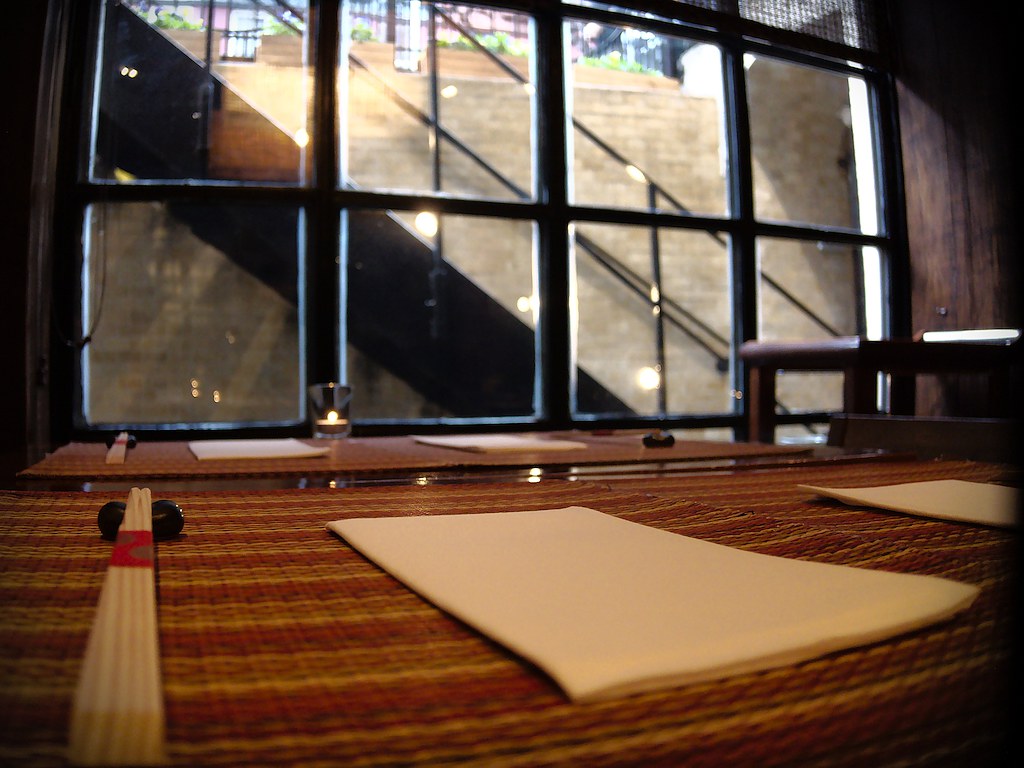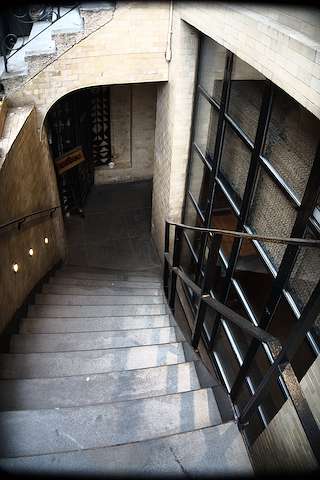Kyo ya post Chikara Sono

I've been planning to visit Kyo ya for a while, but I kept dropping for logistical reasons. When I was planning our most recent trip to New York, I made sure that, once again, it was on the short list (with only reservations at TAK room potentially knocking it off the schedule). Dutifully, I made a note in my calendar to make reservations when availability opened on March 29th.
For those who are not familiar with it, Kyo ya is a Michelin-starred restaurant, acclaimed for its kaiseki dinners; essentially a traditional Japanese tasting menu of several small courses that should compliment each other.1 The restaurant itself is barely noticeable, with no signs to distinguish it other than a sign on a door, at the bottom of a steep staircase leading down from the sidewalk, that simply says "closed" when you wouldn't be going there. It's so easy to miss, that even our dinner partners who knew where they were going walked right past it.
Unfortunately, when I went to make my reservation on OpenTable for Kyo Ya, it had a note that they were no longer serving their kaiseki menu. A quick search confirmed a hypothesis that their head chef, and master of combining seasonally-inspired victuals, Chikara Sono had recently announced that he would be leaving, before our visit, to start his own restaurant.
We kept the reservation. We missed our chance at visiting Kyo ya under Sono-san, but less than a month following his departure was going to be the best time to get a feel for what the menu would have been like under his tenure; besides I'd pushed Kyo ya aside in the past, it felt like, too many times. It was going to be a nice 20 minute walk from where we were staying at the Gramercy Park Hotel, and logistically everything seemed to be falling into place.
Arrival
Jamie and I made good time on our walk from the hotel, actually arriving seven minutes early (17:53, for an 18:00 reservation). We were meeting another couple at the restaurant, and the cross-product of table-for-four availability and our parents-of-eight-month-twins sleep schedule meant we had reservations for the first seating of the night. Walking-in, we were greeted, and offered a seat in the narrow entry-way by the hostess who pointed-out that we were early and that the restaurant was not yet open. After waiting-out our remaining time before our reservation, we were shown to our reserved table. Ours and two tables for two were marked as reserved; a fourth existed in the front of the restaurant and was not indicated. There was another group of tables in the back of the restaurant at the other end of the long bar. The passage along the bar was fairly narrow, with the wall opposite opposite the bar was polished wood, with a couple of hidden doors leading to the rest rooms.2
Kyo-ya entrance, void of signage
The Meal
Obviously, the lack of a kaiseki altered the meal experience. I'm a big fan of a chef designed menu of the day based on what is optimally available and instilling a freshness and whimsy into the meal. The a la carte selection provided servings which fit the concept of several small dishes, so we ordered a selection, including three zensai (appetizers) and usually one or two of the other dishes to share between the four of us. Each zensai included one whelk, two of them looked (and I'm told) were well prepared and tasty; the one I had appeared to be dried-out and had a mostly rubbery texture which made it a bit too chewy and tasteless.
The rest of the meal encompassed gindara nitsuke (simmered cod in sweet soy sauce), eel tsukudani chazuke (braised eel with dashi broth), ebi shinjo (bite sized shrimp-mousse balls and vegetables in a thick yuzu broth), Mame Aji Kara-Age (crispy fried baby horse mackerel3 with Brussels sprouts), snow crab chawanmushi (a small cup of steamed custard, with chunks of the crab baked-in). We variously ordered the aigamo (thinly sliced roasted duck), kurobuta kakuni (slowly cooked pork belly), or cold inaniwa udon ahead of the final course four all four of us was the seasonal clay pot of white rice, which we had made with mackerel (crab was also an option).
These were all in the $14-$18 range, other than the gindara (which was $36) and seasonal clay pot rice (listed at $42, but described as market price based on what we added to it). Many of the dishes we shared, splitting two or three plates for the four of us, but you can see how this can quickly surpass the price of the custom curated kaiseki menu for which it was famous. The sake menu seemed fairly reasonable. I've seen larger sake selection at many a sushi-ya in major US cities, and not being a particularly knowledgeable sake connoisseur, I can't say if Kyo Ya's selection is particularly interesting4.
We started our meal with a Maboroshi Junmai Ginjo. Reading about this particular sake online after the meal, I find descriptions of its delicate, crisp flavour of green apple. The menu was less poetic, describing it as neutral and having no taste, which matched my experience. It wasn't bad, it just lacked any defining characteristic, and was like drinking a good Vodka, or simply water. If you want a kirei sake, it seems like a good choice. We split a 720ml bottle.
We followed-up Tedorigawa Yamahai Junmai Daiginjo. I'd wanted something with a bit more character, and the higher acidity and earthiness sounded appealing as we finished our appetizer and our next courses were arriving. This was only offered in a 300ml bottle.
This sake is made from Gohyakumangoku rice, which was polished to 65%, and has an SMV +4 and an Acidity of 1.5. As it is a Yamahai, no lactic acid was added to the yeast starter. Instead, natural lactic acid from the air was allowed to drop into the yeast starter, a process which usually takes twice as long and tends to give an earthy or gamey flavor to the sake. In addition, a Yamahai is generally richer in umami than most other sake types.
Finally, I figured we'd go to the complete opposite end of the spectrum as we began, with the unfiltered Tsukinoi Junmai Muroka Nama Genshu in a 720ml bottle. This sake had character, presenting a level of salinity and minerality not typically present in sake. It was a hit with our table (especially the Laphroig-loving half).
Conclusion
The meal and experience were both enjoyable, and I'm still glad to have been able to make it to Kyo ya. Despite that, there were several things which keep Kyo ya from being one of our preferred restaurants. Service had feints towards the higher-end, but wasn't without problems. There were long stretches during our dinner where the table's water and at least one diner's glass were empty for long periods; at one point our sake was also empty leaving no drinks at the table. Getting the check was also a bit difficult, as our waiter seemed to be actively keeping his back to us, even as he served the table next to us and behind us. The food was good, and other than an overdone whelk, well prepared. The sake menu was fairly varied, but not among the most extensive I've experienced; but sake prices were very reasonable. You can still create your own pseudo-kaiseki from the menu, but prices for the food do add-up quickly, and the current menu is fairly small meaning there won't be a lot of variety if you decide to return.
Kyo Ya currently has one Michelin star, among its other praises. The Michelin guide qualifies its ratings as high quality cooking, worth a stop and quite comfortable. The food is still tasty, and the restaurant itself still feels special, but unless the restaurant can find a new source for inspiration and the creativity it previously demonstrated in its kaiseki menu, I wouldn't be surprised to see it slip from the list of starred restaurants.
Since Kyo ya first appeared in Michelin's list, other kaiseki restaurants have opened-up, including fairly recently Shuko which is still on my list to try.
Rather than directing you to the restrooms if you ask, they'll lead you to the wall and open the hidden door for you, it's both very neat and a little weird.
the menu split this after horse in the description, which lead to some shock from members of our party, despite veal getting a pass
Michelin, who presumably has experts, did say this